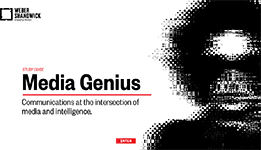A new interactive study guide from Weber Shandwick attempts to crack the code of intelligent technology for people working in the communications industry.
Media Genius, an outgrowth of Weber’s “Solving for X” tech newsletter, is an interactive guide that provides a rundown of the terms and concepts that have defined the current digital landscape. It also explains what those developments mean for communicators who want to make sure their messages get heard over the hype and the buzz.
 |
The guide covers a broad range of topics—from the difference between artificial intelligence and machine learning to the rise of synthetic content (such artificially created media as computer-generated influencers and augmented reality).
In addition to giving capsule definitions of these developments, Media Genius takes a look at the risks and opportunities each of them represents. For example, while it notes that artificial intelligence gives communicators the ability to personalize content, deliver new customer experiences and create greater efficiencies, it also lists a few potential problems. Among them: changes in job requirements (along with the threat of job losses) and increasing consumer distrust when it comes to human/machine interactions.
Though the guide presents a sizeable chunk of information, its interactive form gives users the ability to tailor the content to their specific needs. The table of contents offers the option of going directly to a specific section with one click, and options are provided to access a wealth of supplementary materials. There are also links to online courses at such institutions as Stanford, Rutgers and Boston University that address the subjects outlined in the guide.
The overriding theme of Media Genius is that previous developments in digital technology are likely to be dwarfed by the effects of the new forms of machine-based intelligence. To respond to those effects, the guide says, communicators need to develop an understanding of how that intelligence works.
“Technology is no longer just a tool for communications directed by human intelligence,” Weber Shandwick chief digital officer Chris Perry wrote in a March 18 post on Medium. “It has its own intelligence—one that at times augments human understanding, and at other confounds it. The implications—for businesses, for society, for communicators, couldn’t be greater.”


 Laura Anderson, who rose to VP/GM of global communications and events in a nearly 20 year stint at Intel, will take on the Americas technology chair at Burson following the completion of the BCW and H+K merger on July 1.
Laura Anderson, who rose to VP/GM of global communications and events in a nearly 20 year stint at Intel, will take on the Americas technology chair at Burson following the completion of the BCW and H+K merger on July 1. WE Communications has partnered with ROKK Solutions to form the WE ROKK AI service.
WE Communications has partnered with ROKK Solutions to form the WE ROKK AI service. In the dynamic world of modern business, effective communication is a pivotal tool for success across various industries. At Communications Strategy Group (CSG®), our expertise in embracing innovation in communication extends beyond traditional marketing strategies, paving the way for transformative industry-specific solutions.
In the dynamic world of modern business, effective communication is a pivotal tool for success across various industries. At Communications Strategy Group (CSG®), our expertise in embracing innovation in communication extends beyond traditional marketing strategies, paving the way for transformative industry-specific solutions. There are two types of tech PR professionals. Which one are you? And are C-suite executives making that decision for you?
There are two types of tech PR professionals. Which one are you? And are C-suite executives making that decision for you? While there’s an impulse to grab reporters’ attention with the newest industry-transforming tech product or service, a back-to-basics approach focused on telling the right stories to the right people is a far more successful way to ensure your technology campaign breaks through the clutter of today’s crowded tech landscape.
While there’s an impulse to grab reporters’ attention with the newest industry-transforming tech product or service, a back-to-basics approach focused on telling the right stories to the right people is a far more successful way to ensure your technology campaign breaks through the clutter of today’s crowded tech landscape.


 Have a comment? Send it to
Have a comment? Send it to 
No comments have been submitted for this story yet.